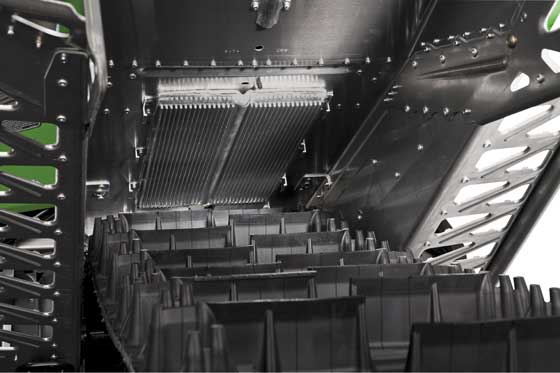Snowmachine Cooling
Systems
Just like any other motorized vehicle, snowmachines
generate a lot of heat, despite being operated in and on snow in
winter. While some machines are fan cooled, most of them utilize
the snow and are liquid cooled. Fan cooled snowmachines quite
simply use a fan to circulate air over the engine and dissipate
heat via convection. They are typically lighter in weight, but
are inefficient and inadequate for high-performance
snowmachines. Liquid cooled machines are
very similar to any other liquid cooled engine in that cooling
tubes surrounding the engine components create a heat exchanger
that transfers heat from the engine to the liquid coolant via
conduction. The primary difference is that while most vehicles
cooling systems rely on airflow as the heat sink for the
secondary heat exchanger, a snowmachine relies on the snow
itself. The heated coolant is circulated through a secondary
heat exchanger which is located on the bottom of the snowmachine
tunnel, just above the track. As the track rotates and propels
the machine, the paddles on it kick snow up against this heat
exchanger, providing a very cold heat sink. While this system is
very efficient, it is not without its problems. Because there is
very little airflow in between the track and the tunnel, this
system is fully dependent on snow to operate properly. If you
are driving on ice or hard-packed snow for extended periods the
engine can easily overheat. If you are riding in deep powder,
the cooling system works flawlessly, but melting snow on the
rear heat exchnager can cause ice buildup along the tunnel which
can interfere with the track and increase weight, making it
harder to ride.
Liquid cooled machines are
very similar to any other liquid cooled engine in that cooling
tubes surrounding the engine components create a heat exchanger
that transfers heat from the engine to the liquid coolant via
conduction. The primary difference is that while most vehicles
cooling systems rely on airflow as the heat sink for the
secondary heat exchanger, a snowmachine relies on the snow
itself. The heated coolant is circulated through a secondary
heat exchanger which is located on the bottom of the snowmachine
tunnel, just above the track. As the track rotates and propels
the machine, the paddles on it kick snow up against this heat
exchanger, providing a very cold heat sink. While this system is
very efficient, it is not without its problems. Because there is
very little airflow in between the track and the tunnel, this
system is fully dependent on snow to operate properly. If you
are driving on ice or hard-packed snow for extended periods the
engine can easily overheat. If you are riding in deep powder,
the cooling system works flawlessly, but melting snow on the
rear heat exchnager can cause ice buildup along the tunnel which
can interfere with the track and increase weight, making it
harder to ride.
 Liquid cooled machines are
very similar to any other liquid cooled engine in that cooling
tubes surrounding the engine components create a heat exchanger
that transfers heat from the engine to the liquid coolant via
conduction. The primary difference is that while most vehicles
cooling systems rely on airflow as the heat sink for the
secondary heat exchanger, a snowmachine relies on the snow
itself. The heated coolant is circulated through a secondary
heat exchanger which is located on the bottom of the snowmachine
tunnel, just above the track. As the track rotates and propels
the machine, the paddles on it kick snow up against this heat
exchanger, providing a very cold heat sink. While this system is
very efficient, it is not without its problems. Because there is
very little airflow in between the track and the tunnel, this
system is fully dependent on snow to operate properly. If you
are driving on ice or hard-packed snow for extended periods the
engine can easily overheat. If you are riding in deep powder,
the cooling system works flawlessly, but melting snow on the
rear heat exchnager can cause ice buildup along the tunnel which
can interfere with the track and increase weight, making it
harder to ride.
Liquid cooled machines are
very similar to any other liquid cooled engine in that cooling
tubes surrounding the engine components create a heat exchanger
that transfers heat from the engine to the liquid coolant via
conduction. The primary difference is that while most vehicles
cooling systems rely on airflow as the heat sink for the
secondary heat exchanger, a snowmachine relies on the snow
itself. The heated coolant is circulated through a secondary
heat exchanger which is located on the bottom of the snowmachine
tunnel, just above the track. As the track rotates and propels
the machine, the paddles on it kick snow up against this heat
exchanger, providing a very cold heat sink. While this system is
very efficient, it is not without its problems. Because there is
very little airflow in between the track and the tunnel, this
system is fully dependent on snow to operate properly. If you
are driving on ice or hard-packed snow for extended periods the
engine can easily overheat. If you are riding in deep powder,
the cooling system works flawlessly, but melting snow on the
rear heat exchnager can cause ice buildup along the tunnel which
can interfere with the track and increase weight, making it
harder to ride.